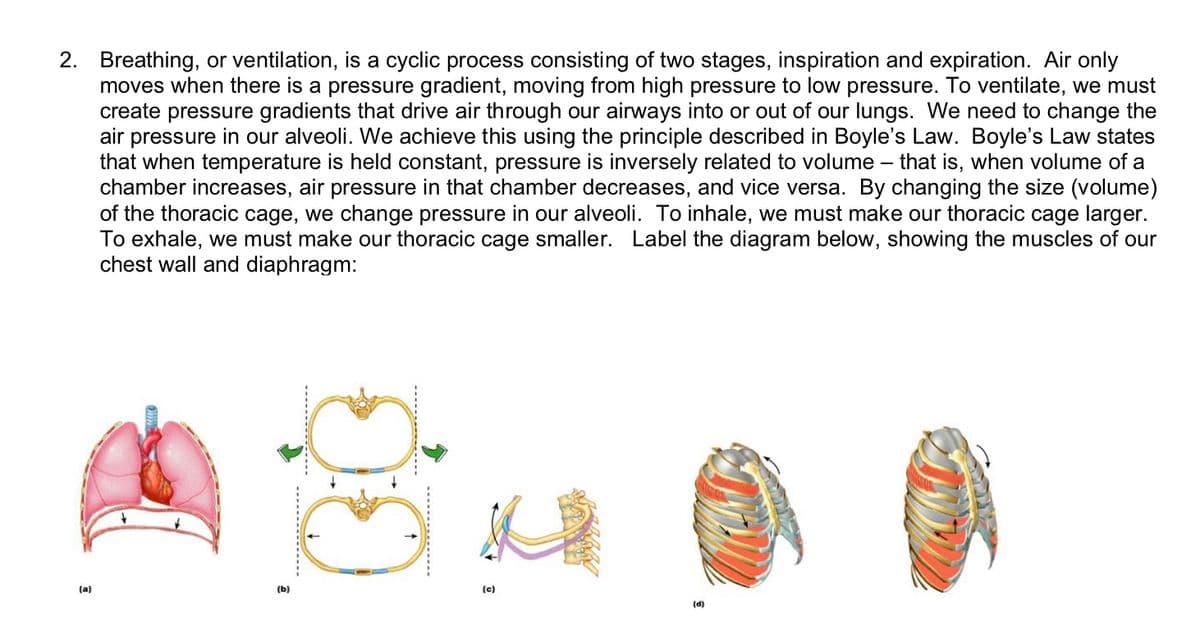2. Breathing, or ventilation, is a cyclic process consisting of two stages, inspiration and expiration. Air only moves when there is a pressure gradient, moving from high pressure to low pressure. To ventilate, we must create pressure gradients that drive air through our airways into or out of our lungs. We need to change the air pressure in our alveoli. We achieve this using the principle described in Boyle's Law. Boyle's Law states that when temperature is held constant, pressure is inversely related to volume - that is, when volume of a chamber increases, air pressure in that chamber decreases, and vice versa. By changing the size (volume) of the thoracic cage, we change pressure in our alveoli. To inhale, we must make our thoracic cage larger. To exhale, we must make our thoracic cage smaller. Label the diagram below, showing the muscles of our chest wall and diaphragm: (a) (b) (e)
2. Breathing, or ventilation, is a cyclic process consisting of two stages, inspiration and expiration. Air only moves when there is a pressure gradient, moving from high pressure to low pressure. To ventilate, we must create pressure gradients that drive air through our airways into or out of our lungs. We need to change the air pressure in our alveoli. We achieve this using the principle described in Boyle's Law. Boyle's Law states that when temperature is held constant, pressure is inversely related to volume - that is, when volume of a chamber increases, air pressure in that chamber decreases, and vice versa. By changing the size (volume) of the thoracic cage, we change pressure in our alveoli. To inhale, we must make our thoracic cage larger. To exhale, we must make our thoracic cage smaller. Label the diagram below, showing the muscles of our chest wall and diaphragm: (a) (b) (e)
Human Anatomy & Physiology (11th Edition)
11th Edition
ISBN:9780134580999
Author:Elaine N. Marieb, Katja N. Hoehn
Publisher:Elaine N. Marieb, Katja N. Hoehn
Chapter1: The Human Body: An Orientation
Section: Chapter Questions
Problem 1RQ: The correct sequence of levels forming the structural hierarchy is A. (a) organ, organ system,...
Related questions
Question

Transcribed Image Text:2. Breathing, or ventilation, is a cyclic process consisting of two stages, inspiration and expiration. Air only
moves when there is a pressure gradient, moving from high pressure to low pressure. To ventilate, we must
create pressure gradients that drive air through our airways into or out of our lungs. We need to change the
air pressure in our alveoli. We achieve this using the principle described in Boyle's Law. Boyle's Law states
that when temperature is held constant, pressure is inversely related to volume – that is, when volume of a
chamber increases, air pressure in that chamber decreases, and vice versa. By changing the size (volume)
of the thoracic cage, we change pressure in our alveoli. To inhale, we must make our thoracic cage larger.
To exhale, we must make our thoracic cage smaller. Label the diagram below, showing the muscles of our
chest wall and diaphragm:
(3
(a)
(b)
(c)
(d)
Expert Solution
This question has been solved!
Explore an expertly crafted, step-by-step solution for a thorough understanding of key concepts.
This is a popular solution!
Trending now
This is a popular solution!
Step by step
Solved in 2 steps with 1 images

Recommended textbooks for you

Human Anatomy & Physiology (11th Edition)
Anatomy and Physiology
ISBN:
9780134580999
Author:
Elaine N. Marieb, Katja N. Hoehn
Publisher:
PEARSON

Anatomy & Physiology
Anatomy and Physiology
ISBN:
9781259398629
Author:
McKinley, Michael P., O'loughlin, Valerie Dean, Bidle, Theresa Stouter
Publisher:
Mcgraw Hill Education,

Human Anatomy
Anatomy and Physiology
ISBN:
9780135168059
Author:
Marieb, Elaine Nicpon, Brady, Patricia, Mallatt, Jon
Publisher:
Pearson Education, Inc.,

Human Anatomy & Physiology (11th Edition)
Anatomy and Physiology
ISBN:
9780134580999
Author:
Elaine N. Marieb, Katja N. Hoehn
Publisher:
PEARSON

Anatomy & Physiology
Anatomy and Physiology
ISBN:
9781259398629
Author:
McKinley, Michael P., O'loughlin, Valerie Dean, Bidle, Theresa Stouter
Publisher:
Mcgraw Hill Education,

Human Anatomy
Anatomy and Physiology
ISBN:
9780135168059
Author:
Marieb, Elaine Nicpon, Brady, Patricia, Mallatt, Jon
Publisher:
Pearson Education, Inc.,

Anatomy & Physiology: An Integrative Approach
Anatomy and Physiology
ISBN:
9780078024283
Author:
Michael McKinley Dr., Valerie O'Loughlin, Theresa Bidle
Publisher:
McGraw-Hill Education

Human Anatomy & Physiology (Marieb, Human Anatomy…
Anatomy and Physiology
ISBN:
9780321927040
Author:
Elaine N. Marieb, Katja Hoehn
Publisher:
PEARSON